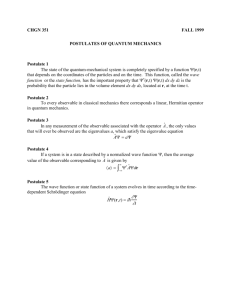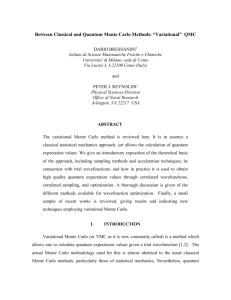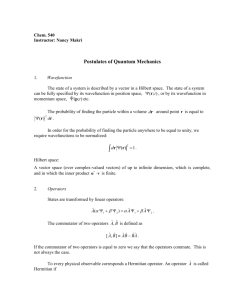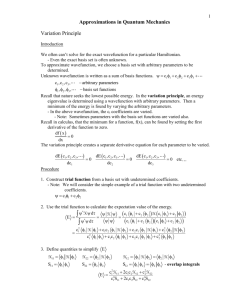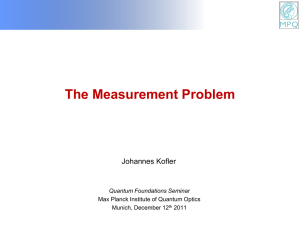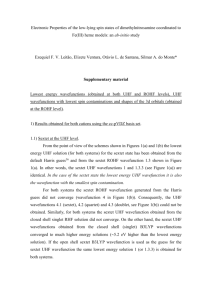Trial wavefunction form
advertisement
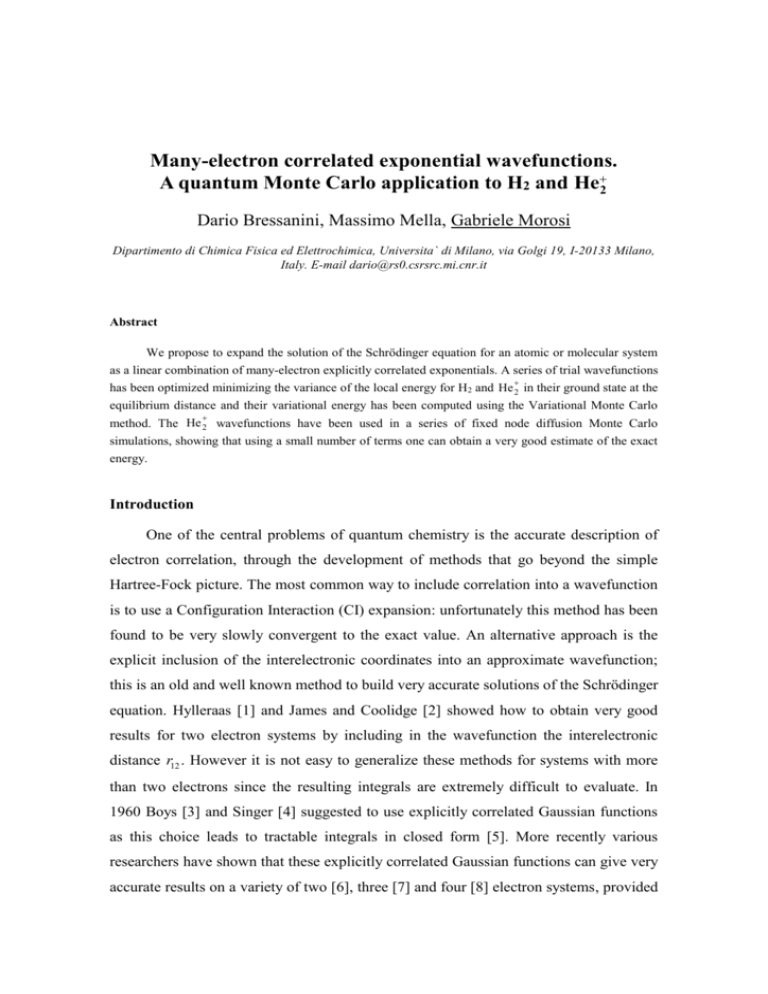
Many-electron correlated exponential wavefunctions. A quantum Monte Carlo application to H2 and He2 Dario Bressanini, Massimo Mella, Gabriele Morosi Dipartimento di Chimica Fisica ed Elettrochimica, Universita` di Milano, via Golgi 19, I-20133 Milano, Italy. E-mail dario@rs0.csrsrc.mi.cnr.it Abstract We propose to expand the solution of the Schrödinger equation for an atomic or molecular system as a linear combination of many-electron explicitly correlated exponentials. A series of trial wavefunctions has been optimized minimizing the variance of the local energy for H 2 and He 2 in their ground state at the equilibrium distance and their variational energy has been computed using the Variational Monte Carlo method. The He 2 wavefunctions have been used in a series of fixed node diffusion Monte Carlo simulations, showing that using a small number of terms one can obtain a very good estimate of the exact energy. Introduction One of the central problems of quantum chemistry is the accurate description of electron correlation, through the development of methods that go beyond the simple Hartree-Fock picture. The most common way to include correlation into a wavefunction is to use a Configuration Interaction (CI) expansion: unfortunately this method has been found to be very slowly convergent to the exact value. An alternative approach is the explicit inclusion of the interelectronic coordinates into an approximate wavefunction; this is an old and well known method to build very accurate solutions of the Schrödinger equation. Hylleraas [1] and James and Coolidge [2] showed how to obtain very good results for two electron systems by including in the wavefunction the interelectronic distance r12 . However it is not easy to generalize these methods for systems with more than two electrons since the resulting integrals are extremely difficult to evaluate. In 1960 Boys [3] and Singer [4] suggested to use explicitly correlated Gaussian functions as this choice leads to tractable integrals in closed form [5]. More recently various researchers have shown that these explicitly correlated Gaussian functions can give very accurate results on a variety of two [6], three [7] and four [8] electron systems, provided that careful optimization of the nonlinear parameters is performed. Unfortunately this type of function poorly reproduces the cusp conditions [9], i.e. the behaviour of the wavefunction when two particles collide, and this has the unpleasant effect of slowing down the convergence. As a result, a very large number of functions is needed to reach high accuracy, increasing the number of nonlinear parameters, and making their optimization a very demanding task. Another popular and effective approach of building compact explicitly correlated wavefunctions is to multiply an SCF wavefunction by a correlation factor, the common choice for the correlation factor being a Jastrow factor [10]. The inclusion of the Jastrow factor does not allow the analytical evaluation of the integrals, so one has to turn to a numerical technique. Although the inclusion of a Jastrow factor has been shown to largely improve the simple SCF function, using a more sophisticated determinantal part, such as an MCSCF or truncated CI expansion, multiplied by a Jastrow factor [11,12], does not always lead to large improvements in the quality of the wavefunction. As a consequence the research so far has focused mainly on developing better correlation factors [13,14]. In this letter we explore the possibility of expanding the wavefunction as a linear combination of explicitly correlated functions, a field recently reviewed by Rychlewski [15], but we suggest using correlated exponentials functions instead of correlated Gaussians, in the spirit of Boys and Singer. This allows a good description of the cusp conditions and should reduce the number of terms needed to obtain the desired accuracy, alleviating the problem of the optimization of the nonlinear parameters. This ansatz was used by Thakkar and Smith [16] within the integral-transform method for two electron systems, but the extension to three or more electrons was estimated “prohibitively expensive”. To avoid the problem of N-dimensional quadrature schemes, the bottleneck of the integral-transform method, we turn to the Variational Monte Carlo (VMC) method [17] to compute the expectation value of the energy. The VMC method has been successfully used in recent years to compute the expectation value of the energy of explicitly correlated trial wavefunctions. The power of the method relies on the fact that the Monte Carlo technique estimates the energy, and all the desired properties, without any need of computing the matrix elements analytically. In this way one is completely free in the choice of the trial wavefunction. The energy is estimated by averaging the local energy H during a random walk in configuration space using a Metropolis algorithm [18] or a Langevin algorithm [19]. VMC is also used in the optimization of the parameters of the trial wavefunction, as described in detail by Umrigar [13]: the variance of the local energy is minimized instead of the energy itself since this has been proved to be numerically much more stable. Trial wavefunction form We propose to approximate the electronic wavefunction of an atomic or molecular system with N electrons and M nuclei with the linear expansion L ci i (1) i 1 where $ (r) exp k d i A$ Of i i N ,S , M S (2) In this equation A$ is the antisymmetrizer operator, O$ is an operator used to fix the space symmetry, when needed. ki is the i-th vector of parameters, while d is the vector of the electron-electron and electron-nucleus distances. N ,S , M S is an eigenfunction of the spin operators S$2 and S$z of the correct spin multiplicity and fi(r) is a function of the Cartesian electronic coordinates N M f i (r ) ( x j X k ) j 1 k 1 ijk ( y j Yk ) ijk ( z j Zk ) ijk r jkijk (3) where ,, and are appropriate integers greater than or equal to zero, and capital letters refer to nuclear coordinates. This form ensures a good description of the cusps and has the correct spin and space symmetry. However the price that has to be paid is the inability to compute analytically the matrix elements of the Hamiltonian, so a numerical method must be used to evaluate the expectation value of the energy. The VMC method is well suited for this purpose since it only requires the evaluation of the wavefunction, its gradient and its Laplacian, and these are easily computed. A possible bottleneck to the extension of this method to many-electron systems is the calculation of the N! exponentials generated by the antisymmetrizer operator. As to the computational time, full optimization of a linear combination of two terms for a three electron system requires approximately one hour on a modern workstation. The H2 molecule Since the purpose of this work is to explore the capabilities of the proposed expansion, we choose the hydrogen molecule as first test, since it is a non trivial example and there are several very accurate calculations with which to compare. For the Hydrogen molecule at the equilibrium distance of 1.4011 bohr we optimized a series of wavefunctions of the form L k d L c j (1 P$12 )(1 i$) e j ( ) (4) j where the permutation operator and the inversion operator have both been included to impose the correct symmetry and k j d k j1r1 A k j 2 r1B k j 3r2 A k j 4 r2 B k j 5r12 (5) where A and B refer to the nuclei. The inclusion of the fi(r) functions was found in test calculations to give negligible improvement for the hydrogen molecule, although they can be important for other systems, and so were not included in the wavefunction form. For each term in equation (4) there are six parameters to optimize, one linear and five nonlinear. We optimized them minimizing the variance of the local energy using a fixed sample of 2000 VMC configurations, as described in [13]. The L-term wavefunction was constructed by adding one term to the L-1 term wavefunction and reoptimizing all the parameters. Results for L=1,20 are shown in Table 1. It can be seen that the expansion used is quickly convergent (an analysis of the 2 data shows a rough 1/L convergence). A single term alone recovers 87% of the correlation energy and a two terms function already recovers 98% of the correlation energy, while the 20-terms wavefunction has an error in the energy of the order of 10 -5 hartree. The comparison with linear expansions of explicitly correlated Gaussians demonstrates that our 10-term function is roughly equivalent to a 100-term Gaussian expansion, while our 20-term function can be compared to a 300-term Gaussian expansion. The improved quality of our basis can be explained by the fact that Gaussians poorly reproduce the cusps, while the exponentials we used can account for them. Also included in the Table is a comparison with a more familiar ab-initio calculation: it can be seen that a 6-term wavefunction gives the same energy as a full-CI expansion on a very large basis set. The He 2 molecular ion As a further test for our expansion we used a three electron system: the He 2 molecular ion at a bond distance of 2.0625 bohr in its ground 2 u state. As in the previous case, we optimized a series of functions of the form k d L c j A$ (1 i$)e j ( ) L (6) j so for each term there are 10 parameters to be optimized. The minimization of the variance of the local energy was performed using a sample of 2000 VMC configurations. The results in Table 2 show that a single term wavefunction is already able to recover about 80% of the correlation energy (we used the SCF value reported by Liu [23] as an estimate of the HF limit). For comparison with a more common trial wavefunction form, we also report in Table 2 the energy of an optimized SCF wavefunction [2s 1p STO] multiplied by an electron-electron Jastrow factor: this somewhat more complex wavefunction gives an energy worse than our 1-term wavefunction. The overall good performance of our expansion can be judged by comparison with the CI calculation of Liu [23] giving -4.99389 hartree and with an 80term correlated Gaussian expansion [7] giving -4.994091 hartree. Our 12-term function is already better than Liu’s CI calculation. Again, using exponentials instead of Gaussians, there seems to be a reduction by an order of magnitude in the number of terms required for a desired accuracy. One should not be surprised to see that, for example, the 3-term wavefunction gives the same energy as the 4-term one: this is a possible outcome of the Monte Carlo optimization using a small number of sample points coupled with the inability of the minimization routine to find the global minimum instead of a local one. It should also be emphasized that the reported values are the result of a single optimization; no attempt has been made to find the “best” L-term wavefunction using different starting points in the optimization procedure and selecting the best result. Also worthy of note is the reduction of the variance of the estimated energy as the number of terms increases: this is a general effect of Variational Monte Carlo calculations, the more accurate the wavefunction is, the less the uncertainty in the energy for the same simulation length. Optimized correlated wavefunctions are often used in the Diffusion Monte Carlo (DMC) method or in other similar quantum Monte Carlo simulation techniques [24]. These methods need simple, compact and easy to evaluate trial wavefunctions. In the Fixed Node DMC method [25,19], the nodes of a trial wavefunction are used as impenetrable boundaries of a diffusion-type simulation of the Schrödinger equation. A quality that a good trial wavefunction must possess in order to be used with satisfactory results in a fixed node DMC calculation is a good description of the nodes of the exact wavefunction, since this is the only characteristic affecting the energy computed in a DMC simulation. Trial wavefunctions with good variational energies, but poor nodes, give bad results when used in a Diffusion Monte Carlo simulation, while wavefunctions with poor variational energies, but exact nodes, give exact results. We performed three simulations using trial wavefunctions with 1, 4 and 8 correlated exponential terms. The results in Table 2 show that the DMC energy improves with the number of terms, showing that the description of the nodes improves as the number of terms increases. We also notice that the errors in the energy, and consequently the errors in the placement of the nodes, are very small, the result of the simulation with the 8-term function being statistically similar to the best known result. Conclusions We propose as an approximate solution of the Schrödinger equation for atoms and molecules a linear expansion of exponential functions of all the electron-electron and electron-nuclei distances. The expectation values of the energy and other properties must be estimated by a numerical method, the Variational Monte Carlo method being our preferred choice. A relatively small number of terms gives very good expectation values of the energy for H2 and He 2 in their ground state. In both cases the quality of the optimized wavefunction is superior to very large CI expansions, and of the same quality as linear expansions of correlated Gaussians which include an order of magnitude of terms more. The quality of our optimized wavefunctions is demonstrated in the case of the He 2 molecule: when used as trial functions in a Fixed Node Diffusion Monte Carlo simulation, they lead to nearly exact results, a proof of their overall good quality. Acknowledgments Financial support by MURST is gratefully acknowledged. CPU time for this work has been partially granted by the Centro CNR per lo studio delle relazioni tra struttura e reattività chimica, Milano. Table 1 H2 molecule at R = 1.4011 bohr Terms 1 2 3 4 5 6 7 8 9 10 11 12 13 14 15 16 17 18 19 20 Exact HF limit Full CI 100 GTG 300 GTG a Energy (hartree) -1.169435 -1.173624 -1.173935 -1.174118 -1.174177 -1.174296 -1.174336 -1.174416 -1.174386 -1.174414 -1.174443 -1.174440 -1.174452 -1.174451 -1.174447 -1.174450 -1.174430 -1.174462 -1.174462 -1.174460 -1.174476a -1.133623b -1.174285c -1.174382d -1.174462d 0.000187 0.000056 0.000048 0.000038 0.000045 0.000018 0.000012 0.000037 0.000010 0.000008 0.000008 0.000007 0.000007 0.000006 0.000013 0.000017 0.000016 0.000017 0.000017 0.000003 Ref [20] Ref [21] c Full CI 30s20p12d9f GTO Ref [22] d Ref [6] b Table 2 He 2 molecular ion at R = 2.0625 bohr Terms 1 2 3 4 6 8 10 12 15 23 SCF+ Je-e a DMC 1b DMC 4b DMC 8b HFc Full CId 320 SECSGe Energy -4.98078 -4.98487 -4.98995 -4.98995 -4.99249 -4.99351 -4.99355 -4.99400 -4.99413 -4.99436 -4.97620 -4.99422 -4.99435 -4.99455 -4.92270 -4.99387 -4.994598 0.00031 0.00023 0.00016 0.00027 0.00012 0.00012 0.00012 0.00010 0.00008 0.00007 0.00015 0.00017 0.00007 0.00003 a Optimized SCF+Je-e, VMC calculation (this work) b DMC results, after elimination of the time step bias. c Ref [23] d Full CI 5s4p3d2f1g GTO, R=2.05, Ref [23] e R=2.05, Ref [7] References [1] E.A. Hylleraas, Z. Physik 54 (1929) 347. [2] H.M. James and A.S. Coolidge, J. Chem. Phys. 1 (1933) 825. [3] S.F. Boys, Proc. Roy. Soc. A 258 (1960) 402. [4] K. Singer, Proc. Roy. Soc. A 258 (1960) 412. [5] W.A. Lester Jr. and M. Krauss, J. Chem. Phys. 41 (1964) 1407. [6] S.A. Alexander, H.J. Monkhorst, R. Roeland and K. Szalewicz, J. Chem. Phys. 93 (1990) 4230. [7] W. Cencek and J. Rychlewski, J. Chem. Phys. 102 (1995) 2533. [8] W. Cencek and J. Rychlewski, J. Chem. Phys. 98 (1993) 1252. [9] T. Kato, Commun. Pure and Appl. Math. 10 (1957) 151. [10] R. Jastrow, Phys. Rev. 98 (1955) 1479. [11] Z. Sun, R.N. Barnett and W.A. Lester, Jr., J. Chem. Phys. 96 (1992) 2422 [12] H. Bueckert, S.M. Rothstein and J. Vrbik, Can. J. Chem. 70 (1992) 366. [13] C.J. Umrigar, K.G. Wilson and J.W. Wilkins, Phys. Rev. Lett. 60 (1988) 1719. [14] K.E. Schmidt and J.W. Moskowitz, J. Chem. Phys. 93 (1990) 4172. [15] J. Rychlewski, Int. J. Quantum Chem. 49, (1994) 477. [16] A.J.Thakkar and V.H.Smith,Jr., Phys. Rev. A 15 (1977) 1; ibid. 15 (1977) 16. [17] D. Ceperley, G.V. Chester and M.H. Kalos, Phys. Rev. B 16 (1977) 3081. [18] N. Metropolis, A.W. Rosenbluth, M.R. Rosenbluth, A.H. Teller and E. Teller, J. Chem. Phys. 21 (1953) 1087. [19] P.J. Reynolds, D.M. Ceperley, B.J. Alder and W.A. Lester, Jr., J. Chem. Phys. 77 (1982) 5593. [20] W. Kolos, K. Szalewicz and H.J. Monkhorst, J. Chem. Phys. 3278 (1986) 84. [21] Reference 32 in [6] [22] R. Rönse, W. Klopper and W. Kutzelnigg, J. Chem. Phys. 99 (1993) 8830. [23] B. Liu, Phys. Rev. Lett. 27 (1971) 1251. [24] W.A. Lester and B.L. Hammond, Ann. Rev. Phys. Chem. 41 (1991) 283. [25] J.B. Anderson, J. Chem. Phys. 65 (1976) 4121.

